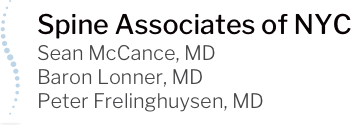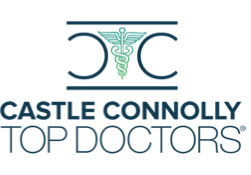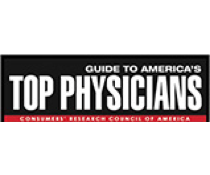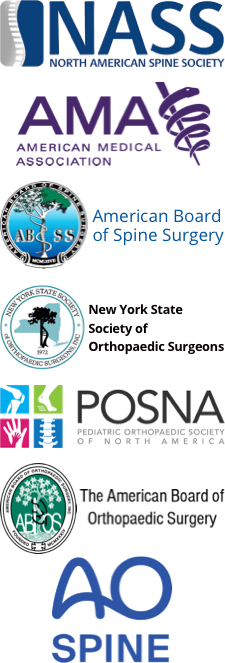Located on the Upper East Side in NYC, Dr. McCance (a top rated board certified orthopedic spine surgeon) regularly diagnoses and treats spinal stenosis (including performing spinal stenosis surgery when necessary). Stenosis can occur anywhere along the spinal cord. It is most common in the lower back (lumbar) and neck (cervical) region. Lumbar spinal stenosis is one of the common causes of lower back pain (and leg pain) and is one of the main reasons people seek accurate diagnosis and medical treatment from Dr. Sean McCance – who is widely regarded as a spinal stenosis specialist. Spinal stenosis is a “quality of life”‘ issue. If your symptoms are acceptable to you then no medical interventions may be necessary and the doctor may suggest management of the condition with medications after an accurate diagnosis is made. If your spinal stenosis condition is chronic and detracting from your quality of life, the NYC spine surgeon may recommend spinal stenosis surgery.
The symptoms of lumbar spinal stenosis include back pain, burning or aching type of pain in the buttocks that radiates to the legs (sciatica), and / or weakness in the legs. Lumbar spinal stenosis may be treated with conservative treatment approaches such as the use of pain medications, physical therapy, steroid injections, or acupuncture. In chronic cases, surgery may be required to treat the condition.
“At the age of 72 my husband suffered from severe spinal stenosis. We had to leave New Mexico to seek treatment and chose Dr. McCance in NYC on the advice of a physician friend. We called on a Thursday, were seen the following Tuesday, had all the required tests, saw a neurologist, got a medical clearance and had surgery the following Wednesday. Dr. McCance’s assistant took the best care of us, we didn’t need to arrange anything, all we had to do was show up and we were completely cared for. This was so important for us since the situation was serious, at least to us, we were far from home and friends and I can not describe how great the experience was. I recommend Dr. McCance to anyone with a spinal problem. He is caring, warm, smart; his staff are courteous and warm and I wish all physicians were like this. He is the best of the best.” ~ Google
Spinal stenosis is a narrowing of the spinal canal. The spinal canal is located within the backbone in a central space that holds the nerve roots and spinal cord. If this space becomes smaller, it can squeeze the nerves and the spinal cord. Depending upon the region of the spine that is compressed, this can cause pain, difficulty walking, leg heaviness or weakness, loss of balance, or loss of bowel and bladder control.
Causes of Spinal Stenosis
Most often spinal stenosis is a result of aging, but some people are born with narrowed canals. Spinal stenosis can also be caused by:
- Osteoarthritis and osteophytes (bony spurs) associated with aging
- Degenerative disk disease
- Herniated disc or bulging disk
- Slipped vertebrae (spondylolisthesis)
- Trauma
- Previous surgery
- Spinal tumors
- OPLL (calcification of the spinal ligament)
Risk Factors for Spinal Stenosis
- Born with a narrow spinal canal
- Age: 50 or older
- Previous injury or surgery of the spine
Symptoms of Spinal Stenosis
Cervical (neck) Stenosis (“Cervical Myelopathy):
- Loss of balance
- Difficulty with fine motor control of the hands (buttoning a shirt, typing, writing, picking change out of a pocket)
- Numbness, tingling, pain, or weakness that radiates down the arms to the hands
- Neck pain or neck fatigue
- Loss of bladder or bowel control
- Partial paralysis of arm or legs
- Leg weakness
Lumbar (lower back) Stenosis:
- Difficulty walking due to leg heaviness or fatigue, or lower back pain
- Numbness, weakness, cramping, or pain in the legs, relieved by sitting
- Pain that radiates down the leg
- Decreased sensation in the feet severe enough to cause difficulty placing the feet when walking
- Partial or complete paralysis of legs in severe cases
- Loss of sexual function
- Loss of bladder or bowel control
Medical Diagnosis of Spinal Stenosis
- The NYC spinal stenosis surgeon will ask about your symptoms and review your medical history
- A physical examination will be performed of the cervical and lumbar spine, arms, and legs, as well as a neurological exam
- The movement, strength, and reflexes of the arms and legs will be tested
- We will order appropriate spinal imaging, or other testing, as needed
- Additional diagnostic tests may be necessary such as MRI, X-rays, CAT Scans, etc.
Possible Treatment Options for Spinal Stenosis
- Nonsteroidal anti-inflammatory drugs ( NSAIDs ) can relieve pain and inflammation.
- Corticosteroid injections can reduce pain and inflammation.
- Oral steroids
- Narcotics
- Physical Therapy: Special exercises can help stabilize the spine and improve mobility. Exercise can increase muscle endurance and the flexibility of the spine. This can relieve some pain. Unfortunately, exercises are often ineffective in treating spinal stenosis and are sometimes contraindicated in severe cases.
- Interventional Spine Care: Steroid injections into the area around the nerve and disk. It is done to reduce pain and inflammation. The injections are used if other medications do not work.
- Bracing: Wearing a corset, lumbar brace, or neck brace can help stabilize the spine and may alleviate pain.
Spinal Stenosis Surgery Performed by Dr. Sean McCance
Spinal stenosis surgery is indicated in progressive cases that do not respond to other treatment, in cases where the quality of life is compromised due to pain and dysfunction, or in cases where neurologic deterioration is occurring. There are many different surgical techniques that can be employed for spinal stenosis by the NYC spine surgeon. Spinal Stenosis surgery generally falls into one of two categories: decompressive surgery or reconstructive surgery (fusion):
- Spinal stenosis decompression surgery (microsurgery, laminectomy, laminotomy, laminoplasty) involves the removal of bony spurs or any increased arthritic material in the spinal canal. This can free up space for the nerves and the spinal cord, relieve the pressure, thereby alleviating symptoms.
- Spinal fusion surgery involves the joining of two or more vertebrae together. This can provide stronger support for the spine, as well as stability. This is done if the spine needs additional support after laminectomy, or if re-alignment of the spine is needed, due to deformity or instability.
When Should You Contact The NYC Spinal Stenosis Specialist, Dr. Sean McCance
Often, back or neck pain improves with time and self-treatment. However, some serious symptoms can occur which may require more immediate medical attention. If your spinal stenosis is severe, progressive symptoms can occur that can become debilitating.
Contact us if your back or neck pain:
- Is severe or gets significantly worse
- Spreads down your legs or arms
- Causes difficulty walking, standing, or moving
- Is associated with:
- Numbness, weakness, or tingling in your buttocks, genitals, legs, or arms
- Loss of bowel or bladder control
- Difficulty with urination
- Fever, unexplained weight loss, or other signs of illness
- Has not started to improve within 7 to 10 days
- Is worse at night, or worse when you lie down
Our best in class, Upper East Side, NYC back & neck pain diagnosis & surgery practice, Spine Associates, is honored to provide you with highly personalized and comprehensive care. Our philosophy of direct management of your case by an expert spine surgeon has made us one of the most trusted and respected spine surgery practices on the Upper East Side in NYC and the world. Feel free to contact the back & neck pain diagnosis and spine surgery specialist today to discuss your unique spinal stenosis condition and start yourself on the road to recovery.
Dr. Sean McCance
1155 Park Avenue, Suite E
New York, NY 10128
(212) 360-6500









